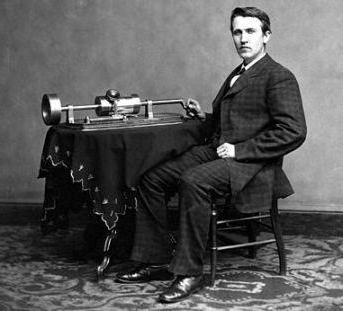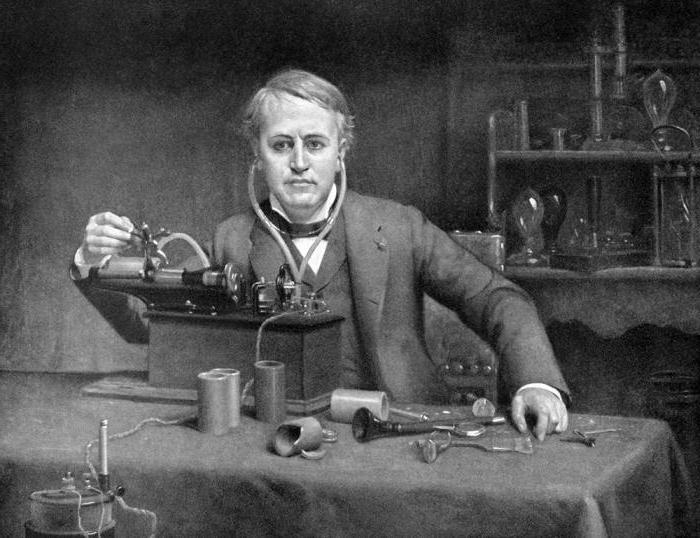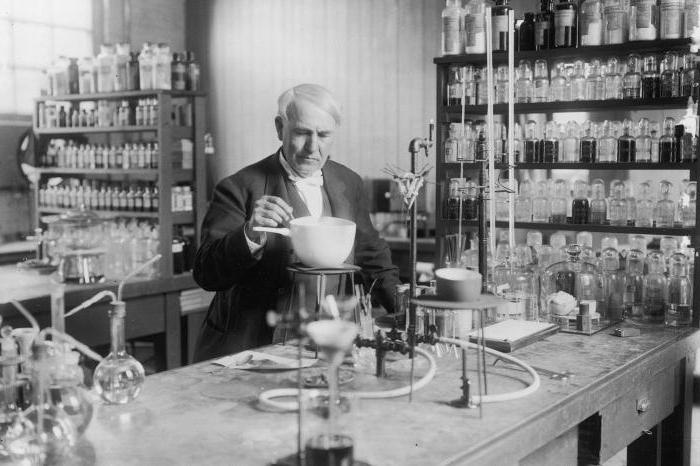Before you start talking about creating the world's first sound recording and reproducing device, you should remember with kind words the author of this truly epoch-making invention. They became an American Thomas Alva Edison. The phonograph is not his only brainchild. It is known that during his long life (1847 ─ 1931) he became the owner of 1,093 patents in his homeland, about 3,000 abroad.
A fantasy that knew no bounds
Edison owns the development of one of the first commercial options for incandescent lamps. In addition, he made a significant contribution to the improvement of cinema equipment, telephone and telegraph. Few people know that even the word “Hello!” So familiar to us came into use with a light hand of this amazing person. In 1928, Edison was awarded the highest US award ─ the Gold Medal of Congress, and two years later received the title of Honorary Foreign Member of the USSR Academy of Sciences.
About Edison's invention of the phonograph, there is quite detailed information. So, according to his own recollections, this idea was prompted by experiments made by him in the course of work related to the improvement of the telephone and telegraph. In 1877, the inventor was busy creating a device that can capture messages in the form of indentations applied to paper tape. Subsequently, they, according to his plan, were to be sent multiple times by telegraph. In this case, it was not about recording sound, but only about converting it into signs available for transmission.
Developing his thought, Edison came to the conclusion that in a similar way you can save a telephone conversation on tape. To this end, he tried to use a membrane equipped with a small press with a needle and using a simple device held above the surface of continuously moving paper coated with a layer of paraffin. His expectations were confirmed: the sound vibrations created by the voice left clearly visible traces on the paper.
Further refinement of the invention
The next step towards Thomas Edison’s creation of a phonograph was the replacement of paper tape with a metal cylinder wrapped in tin foil. This device was already much more complicated, since it had two membranes equipped with needles, one of which was used to record sound vibrations, and the other to reproduce them. The principle of the mechanism remained the same: voice vibrations from words spoken in a shout left traces of various depths on the surface of the roller, which the second membrane had to convert into sound vibrations.

This device, which was the first phonograph in the world, Edison instructed to make on the basis of the drawings created by him to his permanent mechanic ─ John Kruesi. The master worked on this task for almost a month, after which the experiments were continued. It is known that the first "hit", which became the property of the newly invented sound recording, was a short nursery rhyme called "Mary had a lamb." Edison read it into the mouthpiece of the device he created, after which, to great joy and, as he himself admitted, to considerable amazement, he heard his own voice reproduced by the second membrane.
The beginning of a new technical era
It was a truly great moment, thanks to which the world entered the era of sound recording. Subsequently, she went a long way of improvement, from which she still does not descend to this day, but it began in 1877 with a poem about the girl Mary and her little lamb.
About in which year Edison invented the phonograph, his biographers have no doubts, the differences concern only a specific date. It is generally accepted that this event occurred on August 12, 1877, but since it is known that the patent application was filed only at the end of December, many researchers attribute it to a later period, calling September or October.
In addition, records of Edison’s closest assistant and assistant Charles Bachelor were preserved, in which he dates the work on the phonograph by December 1877 and reports that they took no more than two days. In any case, it is known for certain that Edison received the patent certificate for his phonograph on February 19, 1878.
It is interesting to note that in parallel with him, research in the same field was carried out by the Frenchman Charles Cros. He published a work outlining the principle of operation of the device he invented, which had a number of significant differences from Edison's invention, in April of the same 1877. However, he never created a working model. As a result, all his calculations remained only at the level of theory, and Edison deservedly got the palm.
Wonders of Technology
The "talking device" made a real sensation among the Americans. It began with a message that appeared in the December issue of the popular journal Scientific American. This solid scientific publication shared with readers its impressions about how a certain mechanism brought to the editor by Mr. Thomas Edison suddenly spoke in a human voice and, to everyone’s amazement, inquired about the health of those present, and then without any modesty asked if they liked him.
To top it off, the talking machine spoke about its advantages and, before shutting up, wished everyone good night. Since the journalists had never seen and heard anything like this before, the incident caused a real sensation among them. The article, reprinted by other publishers, created widespread advertising for the new invention, thanks to which its author, who, among other things, also had remarkable commercial abilities, began to earn considerable money by arranging public demonstrations of his brainchild. To this end, he officially registered his own company, called Edison's Talking Phonograph.
Since there was no shortage of curiosities and the popularity of the phonograph grew day by day, the inventor sold the right to manufacture it very profitably. At the same time, he earned $ 10,000, which at that time was a huge amount, in addition, stipulated in the contract 20% in his favor of the cost of each sold instance.
Extraordinary features of the miracle machine
It is characteristic that, while inventing the phonograph, Thomas Edison already then, in general terms, foresaw how widespread its discovery would be. Giving an interview in June 1878 to North American magazine, he immediately identified a dozen of these areas:

- With its help, you can dictate letters and various business correspondence without resorting to the services of a stenographer.
- Blind people have the opportunity to use talking books.
- The use of phonograms is one of the ways to study oratory.
- A phonograph is a real opportunity to replicate musical recordings, allowing the general public to listen to the performances of leading world performers.
- Unique family archives can be compiled from the records of votes of relatives.
- On the basis of the phonograph, the possibility of creating talking toys and music boxes opens up.
- Sound recording can over time replace the traditional battle of the clock, announcing with a human voice the beginning and end of the working day, the time for going to bed, etc.
- Sound carriers can provide an invaluable service in preserving languages that are disappearing from use, and accurately reproduce their characteristic manner of speech.
- In the field of public education, Edison suggested using the device he created to record and then listen to the material explained in the lesson by the teacher.
- And finally, in connection with the phone, the phonograph can perform the widest list of functions related to recording and transmitting information.
Unexpected competitors
In 1878, when Edison’s phonograph was universally recognized, the author temporarily left the work to improve it and was fully engaged in the creation of a commercial version of an incandescent lamp. This did not fail to take advantage of other inventors. Thus, the creator of the first telephone, Alexander Bell, having received a significant monetary prize from the French government for his work, used these funds to study acoustic and electrical phenomena and, together with engineer Charles Tainter, was able to significantly improve Thomas Edison's phonograph. In particular, he abandoned the foil covering the roller and replaced it with a layer of wax on which the needle left a sufficient trace for subsequent reproduction.

In 1880, having completed work on the creation of an incandescent lamp, Edison returned to his phonograph. Not wanting to share fame with anyone, he categorically refused the cooperation offered to him by Alexander Bell and Charles Tainter, nevertheless in his further developments he used their idea of replacing the foil with a wax layer.
Start of business
A year after Thomas Edison invented the phonograph, he founded his own company for the production of commercial samples of his brainchild and soon launched the release of “Improved Phonograph” ─ as he called the improved model he developed. In May 1888, another modification was introduced to the market, which also had wide demand among buyers.
Edison's invention of the phonograph gave impetus to the emergence of a new direction in entrepreneurship. It was associated with the production of recording technology. One of the first representatives of this commercial industry, formed at the end of the 19th century, was American Jesse H. Lippincott. He bought an enterprise owned by Edison, as well as several small workshops that had specialized in this field that had appeared by then, and became the sole owner of a license for the production of phonographs.
It should be noted that at that time the quality of the reproduced sound was extremely low and did not allow the full use of these devices for recording musical works. Edison's phonographs were mainly leased by various companies to dictate texts, but even here they could not compete with qualified stenographers. As a result, demand for them fell, and Lippincott lost interest in his venture, and in 1890 he completely transferred the management of affairs to Edison, who, incidentally, was his permanent creditor.
At the service of the entertainment industry
Using the production facilities controlled by him, the inventor launched the production of talking dolls, which immediately conquered the market and began to bring tangible income. Especially for them, Edison developed special tiny wax-coated rollers. Thanks to this innovation, dolls did not just make sounds, but pronounced separate words and even whole phrases.
In addition, Edison's phonograph, the photo of which is given in the article, has found application in the manufacture of prototypes of modern jukeboxes that appeared overseas in the late XIX century. This clearly showed contemporaries that the future of recording technology is inextricably linked with the entertainment industry.
On the wave of commercial success
In 1894, a company headed by Edison, but actually owned by Jesse H. Lippincott, declared bankruptcy, which gave the inventor the opportunity to again become the owner of the rights to his offspring. However, by law, for two years he could not continue to produce phonographs. This period Edison used for their further improvement.
In 1886, he founded the National Phonographic Company, after which his business reached a new level. The quality of the manufactured goods was improved due to the introduction of new advanced technologies. He began to equip his products with spring, and then electric motors.
At the same time, turnover grew. Enterprises owned by the inventor of the phonograph Edison appeared and earned a good reputation not only in America but also in many countries of Europe. Production and sale of this type of equipment was carried out until 1912, when new sound carriers ─ discs that quickly conquered the market announced themselves in full voice.
Fly in the ointment, spoiling a barrel of honey
When Edison invented the phonograph, his brainchild had two significant drawbacks. The first of them was that, due to the design features, the duration of the phonogram did not exceed two minutes. The second and main drawback was the lack of the ability to create a large number of copies of the sounding cylinder. As a result, for their commercial reproduction, artists had to repeat their numbers repeatedly, which created a lot of inconvenience and increased the cost of the product.
Throughout the entire phonograph release period, Edison has made numerous attempts to solve these problems by technical improvement of his invention. We must pay tribute, he has made some progress. The last time he succeeded in 1899, when a new modified model of a concert phonograph with an enlarged cylinder appeared on store shelves. However, over time, and it gave way to devices in which the sound track was applied to the disc, which allowed even in the earliest samples to increase the duration of the recorded phonogram to 4 minutes.
How to make a do-it-yourself Edison phonograph model?
Today, this invention, so once striking the imagination of people, has become a museum exhibit. However, interest in him is very great, as evidenced by the desire of many technology lovers to create Edison's phonograph with their own hands. To facilitate their task, at the end of the article there is a photo with the image of such a home-made device.
We will only explain that as a cylinder ─ a sound carrier - you can use a plastic cup. A paper cup with a needle attached to it is quite suitable for the role of the membrane. The whole structure is driven by a conventional electric motor. On the basis of this simple scheme, each “home-made master” can, using imagination, create an assembly at home that is not inferior to the one that Edison immortalized his name with.